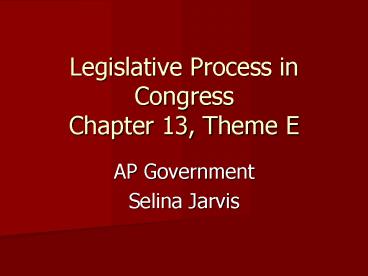Legislative Process in Congress Chapter 13, Theme E - PowerPoint PPT Presentation
Title:
Legislative Process in Congress Chapter 13, Theme E
Description:
Legislative Process in Congress Chapter 13, Theme E AP Government Selina Jarvis Paradox: Functions of Congress Lawmaking Representation Are these two things compatible? – PowerPoint PPT presentation
Number of Views:105
Avg rating:3.0/5.0
Title: Legislative Process in Congress Chapter 13, Theme E
1
Legislative Process in CongressChapter 13, Theme
E
- AP Government
- Selina Jarvis
2
Paradox Functions of Congress
- Lawmaking
- Representation
- Are these two things compatible?
- Quick overview of process
- http//classic.hippocampus.org/course_locator?cour
seAP Government and Politicslesson18topic1wi
dth800height684topicTitleRoute20of20a20Bil
l20through20CongressskinPathhttp//classic.hip
pocampus.org/hippocampus.skins/default
3
Lawmaking Trustee focus
- Goalsolutions to national problems
- Responsibilities
- Legislative Oversight- Oversee what Exec. Br.
bureaucracy is doing - Educate Public- Avenue through which public can
be informed about pending legislationHearings
held - Resolves conflictTreaty approval, clarify
through legislation - Provide securityFunds military other security
forces, creates new ones via laws.
4
Representation Delegate Focus
- Goalrepresent constituents of their districts
and protect their interests - Responsibilities
- Services to constituents Exs?
- Protect districts generally protect interests
within district Exs.? - Pork-channel federal funds into their districts
Exs.?
5
How a Bill becomes a Law
- Step 1 Creation
- Draft a bill- anyone can draft a bill, only
members of Congress can introduce one - Ideas may come from lawmaker, constituents,
special interest groups, etc. - Factors to consider
- ideal law- Can it pass?
- What is content? How much money is asked for? Who
is going to implement the bill? (Power)
6
How a Bill becomes a Law
- Step 2 Introduction
- All appropriation bills begin in the HOR. This
includes the federal budget. - HOR bill is put in the hopper. Senator is
recognized. After 1st reading, it is titled
numbered. (HR or S) - Referral- Speaker/Leaders decides which committee
bill is sent to. Usually multiple committees
(multiple referrals) look at new bill, esp. in
HOR - BCD bill can die!
7
How a Bill becomes a Law
- Step 3 Committee Action
- Standing Committee Considers
- Vehicle by which bills are sorted throughreduce
- Senate committees consider confirmations of all
appointments approval by 2/3 of all treaties. - Committee Actions
- Sent to subcommittee to study recommend
- Pigeonhole bill
- Public Hearings held on bill
- http//www.youtube.com/watch?vdAOUTydryLofeature
related - Mark up session
- Full Committee vote to report out or not
- BCD
8
How a Bill becomes a Law
- Step 4 Floor
- Senate uses unanimous consent to bring to floor
- House Rules Committee- important to leadership of
Congress under direct control of Speaker. Makes
rules regarding how bill will be debated on floor
and when (and if) it reaches floor - 3 types of rules
- Open- any amendments can be offered (Germane only
in HOR) - Closed- no amendments (typical of majority party
nearly all appropriation bills in HOR) - Modified- Combination of two- ex. Certain types
of amendments
9
How a Bill becomes a Law
- Step 5 Voting- complicated process
- Basic steps
- Adopt rules (HOR)
- Debate by paragraph
- HOR time limitsusually 5 minutes
- Filibuster/Cloture
- Amending phase, usually Senate
- Vote (HOR Roll Call/Teller Senate Voice,
Standing or Roll Call/Teller) - BCD
10
How a Bill becomes a Law
- Step 6 Other House
- If bill makes it this far, it now goes to the
other house for consideration. - The process of steps 1-5 is repeated in the other
house - BCD
11
How a Bill becomes a Law
- Step 7 Conference
- Conference Committee- composed of supporters from
both chambers of both parties - Must make compromise bill identical in language
then send it back to House and Senate for
re-approval. BCD
12
How a Bill becomes a Law
- Step 8 Re-approval
- Vote on Conference Committee Bill must be
successful in both chambers. - If successful- Bill moves to Presidents desk
- BCD
13
How a Bill becomes a Law
- Step 9 Presidential Approval
- President gets bill
- Can sign- bill becomes a law
- http//www.youtube.com/watch?vJYq9bZhIyrAfeature
fvst - Can veto- bill with veto message goes back to
house of Congress that originated - http//usgovinfo.about.com/od/thepresidentandcabin
et/a/stemcellveto.htm - Can set aside (Becomes law after 10 days w/o
signature) - Can pocket veto
- BCD
14
How a Bill becomes a Law
- Step 10 Override
- If vetoed- 2/3 majority needed in both chambers
to override - If overridden, bill becomes law.
- According to the Congressional Research service,
from 1789-2008, only 107 of 1,484 regular
presidential vetoes were overridden by Congress.
15
Results of the Legislative Process
- What Happened in the 110th Congress?
- Total number of bills introduced 11059 (3724 in
Senate, 7335 in House) - Total number of bills that became law 442 (134
introduced in Senate, 308 introduced in House) - Percentage of bills that became law 4
- Most popular stage for a bill to die Committee
of the chamber bill is introduced in. - http//assets.sunlightlabs.com/billvisualization/g
raphs/stagehistogram.html
16
More Results
- In the 111th Congress, the House and Senate
passed 383 bills through both houses which were
signed into law by the President. - In the 111th Congress, the House and Senate
passed 2 bills through both houses which were
vetoed by the President. Neither were overridden.

